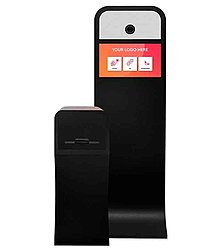Photobooth
A photo booth or photo box ( English photobooth for Fotoautomat ) is a mobile photo studio setup, consisting of a camera and a monitor screen, installed in a still housing. It is mainly used at social events such as weddings, birthdays, trade shows and corporate events and can be rented or purchased from various providers. Usually the structure consists of a background backdrop, the actual photobooth device and a flash system . The additional provision of dressing-up accessories and direct printing of photos with an integrated printer are popular at weddings.
Some providers use the chroma keying technique known from film technology and thereby enable the background scenery to be digitally adjusted. With some providers, photos that have already been taken can be sent directly to social media such as Facebook and Twitter, or via email and SMS .
"Photobooth" is now used as a collective term for various constructions of this type. In English, photo booth generally stands for photo booths (photo booths). The idea of the self-operated photo booth came from Japan and has been known there under the name Purikura since the 1990s .
The first photobooth in the classic sense was first set up in New York on Broadway in 1925. Shortly afterwards these were available all over the world. The photobooth made the final leap to fame in 1963. Andy Warhol photographed models in a photobooth for the well-known fashion magazine Harper's Bazaar. In 1990 the first digital photo booths with color printouts were introduced, but they never achieved the popularity of the chemical black and white photo booths. All today's variants of the photo booth originate from the idea of the traditional photo booth.
Individual evidence
- ↑ Origins of the Purikura Technique. Purikura - the photobooth trend - an article about the origin in Japan.
- ^ A History of the Photobooth by Mark Bloch.

